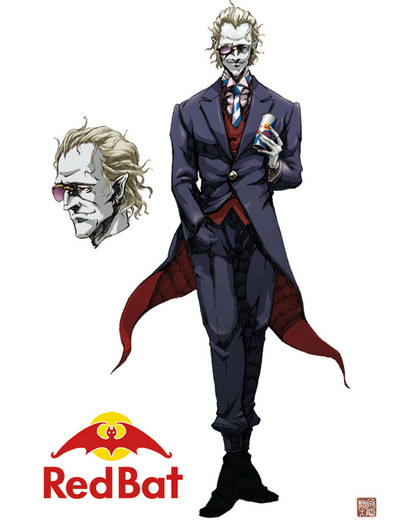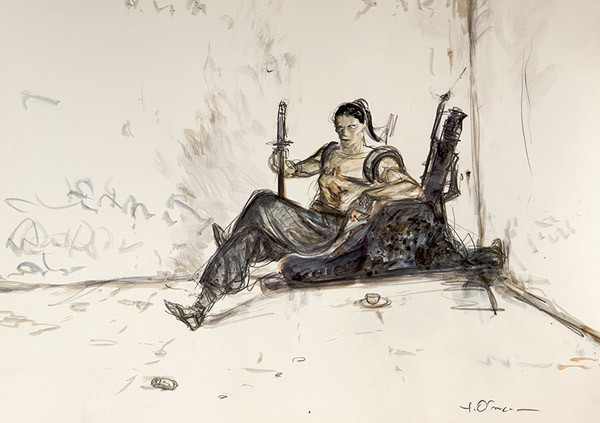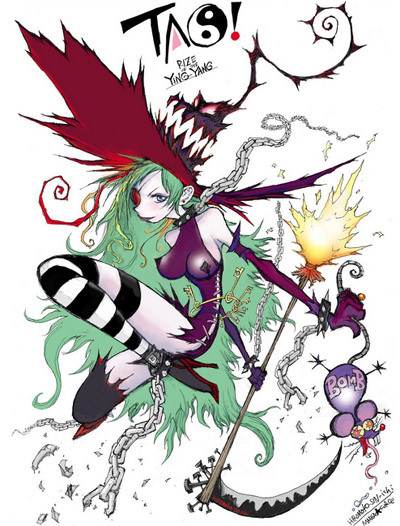Interview: Wikia's Masters of Animanga
by Todd Ciolek,The five creators devised characters, artwork, and general themes for three different stories: Red Bat, Tao: Rise of the Yin-Yang, and Deva Zan. From there, it was up to Wikia's users to flesh out the tales in a collaborative writing project. For a taste of what went into this elaborate team-up, we met up with four of the five talents, plus Wikia's Director of Programming and Entertainment Eric Moro.
We understand this all started with a trip to Japan.
Moro: Yeah, our CEO went out there to meet with some studios and talk about our anime and manga communities. And I think it was more of an introductory conversation, and over the course of those meetings, the idea of doing something with our rabid fanbase was a topic of conversation. And they mentioned this collaborative writing project that we do with our fanon communities, though those are based more on existing intellectual properties, mashing together Doctor Who, Star Wars and that sort of thing.
We took nine days for each story. We started with Red Bat, the vampire story. Then we took a day off and then we did the girls story, Tao: Rise of the Yin-Yang, for nine days, and then ended on the samurai story, which is Deva Zan.
Deva Zan is Yoshitaka Amano's ongoing series, right? Will you do anything more with it?
Moro: No, we're not. It was more that we were invited to play in that playground. Amano gave us the artwork, Koike provided an excerpt.
And how did this whole project compare to Wikia's other collaborations?
Moro: This was our highest showing. Our readers collaborated on about 66,000 words. When you compare it to a traditional paperback novel, that's something.

What did you think of the project when you first heard about it?
Koike: I've been in the professional world, so this was sort of an amateur writing project. So it was exciting to know what people were thinking and how the story goes on.
Okazaki: Well, it seemed like a fun concept at first…
Hiromoto: [laughs] Whoa, wait. You don't mean to say that it wasn't fun after all?
Okazaki: [laughs] What I meant was that it just sounded like a cool idea when Mr. Maruyama approached me. I've always wanted to work with Maruyama, so I was “Oh my God, of course I'd want to participate!” But then I found out I was also working alongside Mr. Amano and Mr. Koike. I nearly wet my pants! This was like my dream! I decided to attend art school after looking at Amano's artwork, and my own Afro Samurai was inspired by Mr. Koike's Lone Wolf and Cub. So I'm totally happy that I'm involved with the project.
Hiromoto: My response is fairly similar. But part of what really impressed me was that these established legends in our own field were collaborating, that they were willing to try out new things, so it actually inspired me to challenge myself with new concepts, and it also led to new ideas and new paths for me. So I received a lot of inspiration by collaborating on this project.
Mr. Maruyama, you've worked on several collaborative projects with overseas companies. How was the Wikia project different?
Maruyama: Well, I've worked with mostly movie studios and anime companies, but this time we're not dealing with those kinds of markets. So that was different. But I've always wanted to challenge the world with unique Japanese cultural aspects. In this case, it's really not that different from what I've been doing. So I think that samurai and katanas are a very strong idea from Japan to challenge the world market, but that path has been paved by Lone Wolf and Cub already, so what we have to do is follow it.

Mr. Koike, how does writing Deva Zan compare to the other samurai stories you've written?
Koike: It's weird to compare the characters, because they're so different. It's hard, really. Like comparing Darth Vader to samurai. The character is really the most important part, and it influences everything. You can't make manga, animation, or video games without the character.
Mr. Maruyama, where do you see the anime industry going when it comes to collaborations with North American companies?
Maruyama: I'd really like a crystal ball to see what's going to happen! But if people have visions, I'll support it and fulfill that vision.
Mr. Hiromoto, what was your inspiration for Hell's Angels? Did that inform your work with the Wikia project?
Hiromoto: Well, I've got a pretty strong personality where I have passionate ideas about what I want to draw and what I want to write. But a lot of times there's a contrast about what I had in my head and what actually gets down on paper. Hell's Angels I wrote five to ten years ago, but at the time I wanted to draw a story with cute girls. I wasn't trying to make it look Western. It was what I wanted to draw. Of course, I do like American comics, but it's not like I was consciously cognizant when I was making Hell's Angels.
It wasn't just the concept of cute girls. I wanted to tie that into a hard-boiled theme of girls who didn't know when they would die. They could die at any moment. So that was a sharp contrast. And then out of the blue I was contacted by Mr. Maruyama, saying “I'd like to make an anime out of this” after only one or two chapters of the story. And it totally blew me out of the water because it was always my dream to be able to collaborate with Mr. Maruyama.

Mr. Maruyama, what was it about Hell's Angels that made you want to adapt it so quickly?
Maruyama: It's not really specifically what I liked. I don't really want to say that any one part of it is attractive. It's just that when I first read it, I felt “I like this” and that's what is important.
Mr. Okazaki, you're known in the West for Afro Samurai. Do you have any plans to do more with it?
Okazaki: [laughs] Keep your ears open!
Mr. Koike, of the many works of yours that haven't been translated yet, is there any particular one that you think American audiences would especially enjoy?
Koike: Well, of the three hundred and forty works I've done, only seven are available in North America. So I'd be glad if half of them were released over here.
Mr. Maruyama, I understand that you're a big fan of dining out, and that you own some restaurants. Do you have a favorite restaurant in New York?
Maruyama: I haven't had the opportunity to go to any restaurants. So if you have any restaurants, you should take me to it!
Is there a particular kind of restaurant you like?
Maruyama: Oh, I eat anything. [laughs] Anything but humans!
Mr. Hiromoto, you worked on some of the Gradius games for Konami. What did you do on the series?
Hiromoto: Well, that was twenty years ago. I came in mostly on Gradius III. I did some drawings and sketches. Before I entered Konami, I never played games at all. Not a single one! When I entered Konami, it was quite an achievement. Hiring me at all was probably a big risk for them!
discuss this in the forum (1 post) |